20 Common Pictures of Bug Bites and How to Identify Their Symptoms
Bugs. The ecosystem can't survive without them, but they sure do know how to ruin a good time. Roasting (and eating lots of) s'mores is less fun when bugs are biting you, but summer fun after sundown isn't the only thing insects can squash. Some invite themselves into your home year-round. It bites—as in, some bugs literally bite, leaving their mark and you in pain and with concern.
The good news? The answer is generally no.
"We share the environment with many insects. Although they can be annoying, most bites and stings are not harmful," says Dr. LouAnne Giangreco, MD, a board-certified emergency medicine physician and the chief medical officer at American Family Care. "However, some bug bites do require medical attention. The ability to distinguish between these bug bites and stings can help ensure you receive the right intervention when needed."
To help, we rounded up photos of common bug bites (or the culprits themselves) and asked doctors to share common symptoms.
When To Seek Medical Attention For Any Bug Bite
Some bug bites, like those from brown recluse and black widow spiders, require prompt medical care, while others can typically be managed at home. However, some people may experience different reactions even to generally "benign" (albeit pesky) bug bites. Dr. Norman Ng, DO, of the Department of Emergency Medicine at Staten Island University Hospital, says these include:
Severe allergic reaction flags, like difficulty breathing, facial or mouth swelling and rapid heartbeat.
Infection signs, such as redness spreading, pus, increasing pain and fever
Systemic symptoms, including nausea, vomiting, dizziness, muscle spasms or weakness
Unusual signs, like blistering, necrosis or an unusual rash.
Persistent symptoms that do not improve with treatment.
If you experience these symptoms, it's important to contact your doctor ASAP.
20 Common Bug Bites (With Photos and Symptom Descriptions)
1. Tick bites
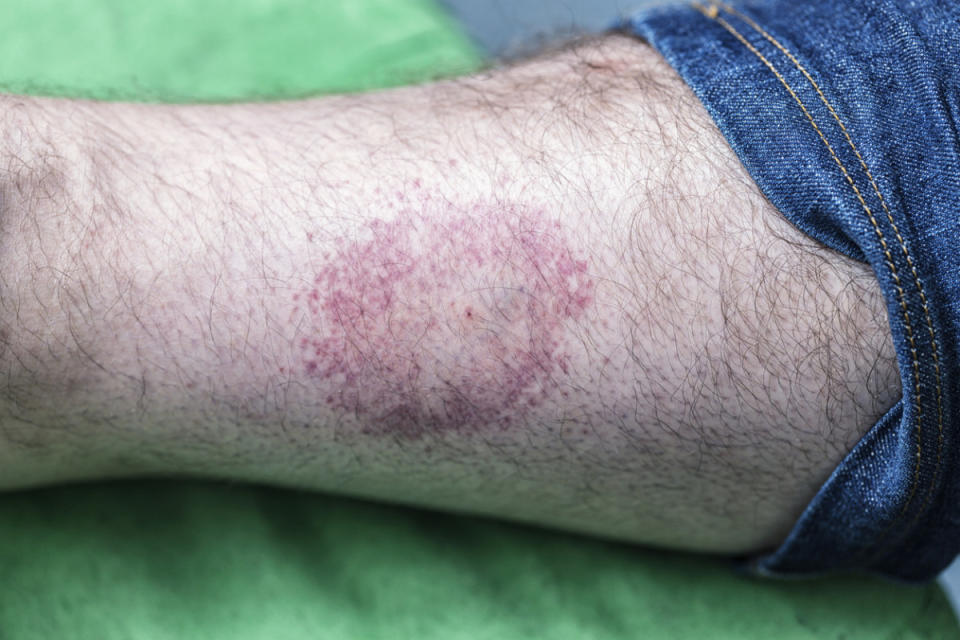
iStock
Dr. Giangreco says ticks can prompt local reactions following a bite. The classic rash of Lyme's is called Erythema migrans. "It can be circular or oval shaped and have crusting," Dr. Giangreco says. However, they can look different.
"Some tick bites can require medical attention," Dr. Giangreco says.
She recommends seeking medical attention, like at an urgent care, if you:
Believe you have a deer dick that's been attached for at least 36 hours (antibiotics could help)
Can't remove an attached tick yourself
Experience tickborne illness symptoms, like fever, rash or joint pain
2. Brown recluse bites
Understanding the symptoms of a brown recluse spider bite can be life-altering.
"Some brown recluse spider bites can cause severe, local reactions with necrotic tissue," Dr. Giangreco says.
These include:
Two puncture marks and redness (often the initial symptom noticed)
Pale center develops later
Blisters around the site
Pain increases over two to eight hours
Dark purple wound
"The bites are self-limited and resolve in a week," Dr. Giangreco says. "For some, it becomes black and necrotic with an ulcer."
Hence, her suggestion to seek care and monitoring.
3. Mosquito bites
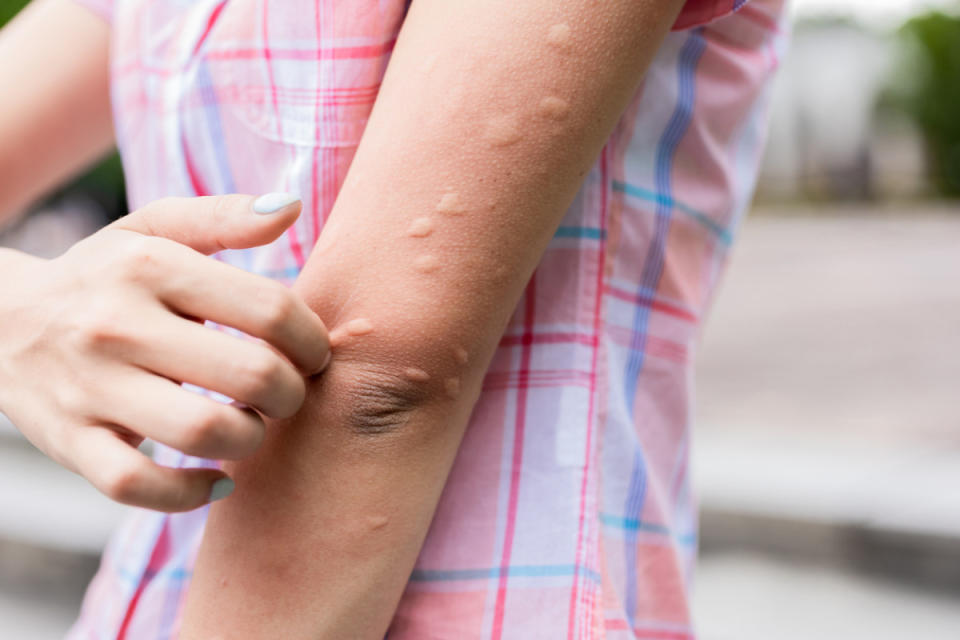
iStock
It's challenging to go through life without getting bitten by a mosquito. For an unpleasant refresher, Dr. Giangreco says mosquito bite symptoms can involve:
Puffy, red bumps that appear minutes after the bite
Hard, itchy, reddish-brown bumps within about a day
Blisters
She says washing with a cool, damp cloth and applying anti-itch treatment can soothe symptoms.
4. Bed bug bites
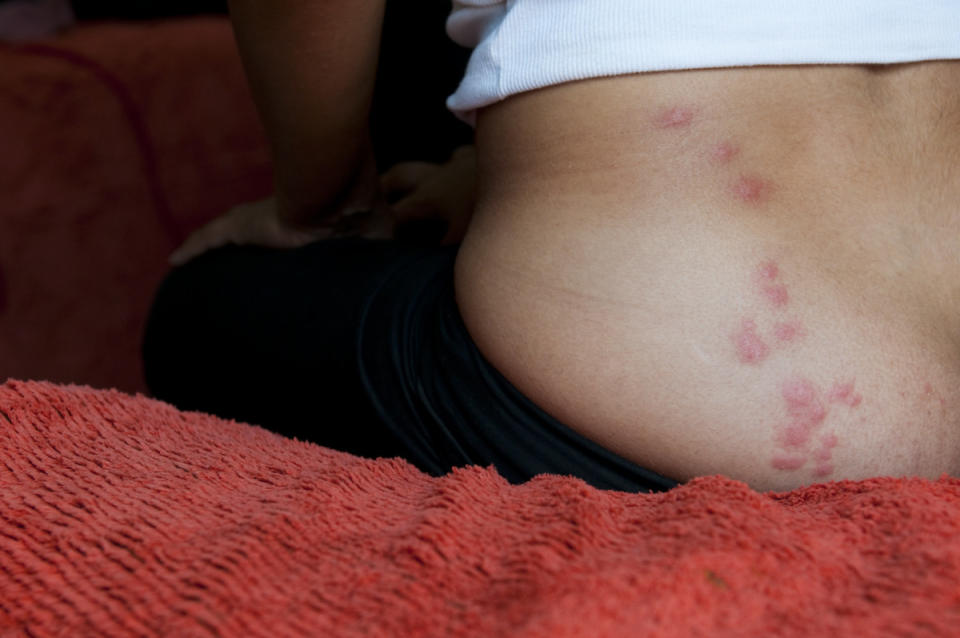
Joel Carillet/Getty Images
"Don't let the bed bugs bite" is a sweet way to say good night. When bed bugs do bite? It can feel rather nightmarish. Dr. Giangreco says you won't feel the initial bite because bed bugs inject an anesthetic. The bite marks appear several days after and may look and feel:
Swollen
Red
Irritated/itchy
Like a straight line (but they can be random)
"Look for bugs in sheets or mattresses, blood stains, exoskeletons or a musty odor," Dr. Giangreco says. "Treat the itch with anti-itch creams, topical corticosteroids or antihistamines."
5. Horsefly bites
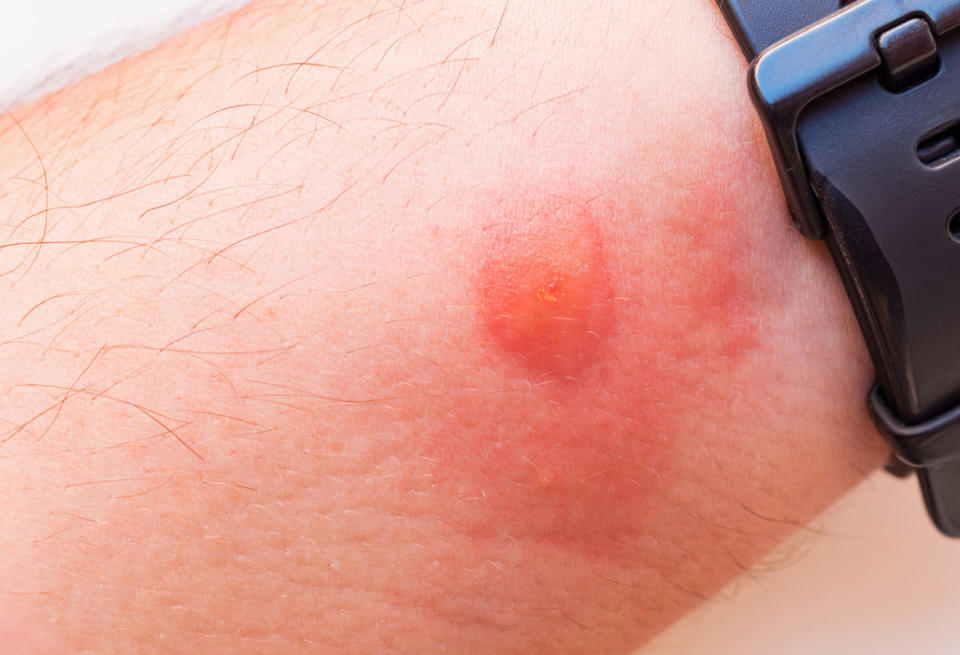
iStock
Dr. Giangreco says painful red bumps are par for the course with horsefly bites. According to the Cleveland Clinic, horseflies live near water in areas where they can easily reach mammals. Despite the name—and their reputation for frequently pestering horses—they'll bug humans too. Female horseflies have mouthparts designed to tear skin so they can feed off mammal blood, and you may feel the bite as it's happening (differentiating it from a mosquito bite).
6. Chigger bites
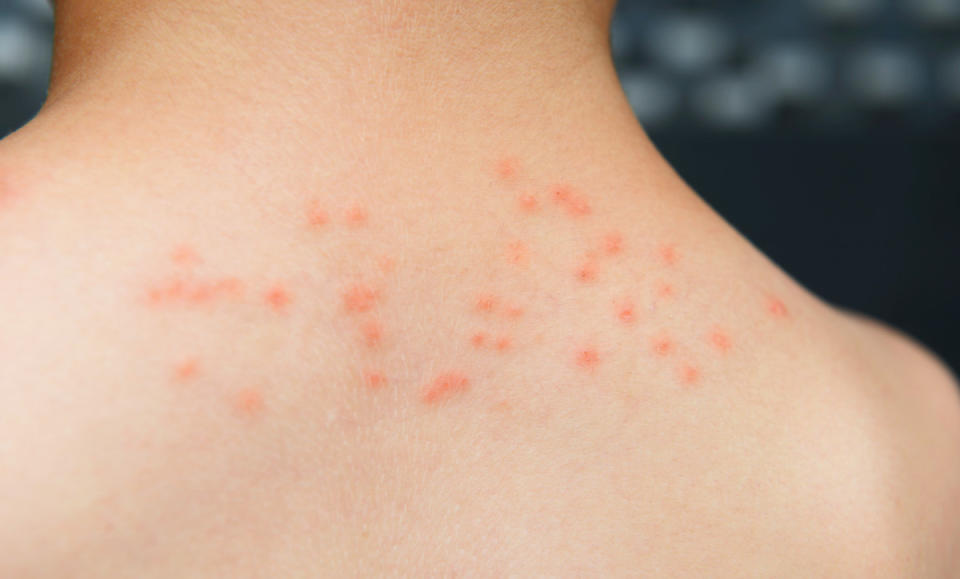
Peter Dazeley/Getty Images
You may also hear these buggers referred to as harvest mites or berry bugs. They generally populate areas loaded with brush, tall grass and dead leaves. Chigger bites are usually more of an annoyance than a problem, and Dr. Giangreco notes that signs may include symptoms like:
Intense itching within a few hours (resolves in a few days)
Red bumps
Hives, red patches or blisters (typically resolves in a week or two)
Dr. Giangreco recommends washing the bite with soap or water and using anti-itch cream, topical corticosteroids or antihistamines. Washing clothes in hot water is also a good idea.
7. Fire ant bites
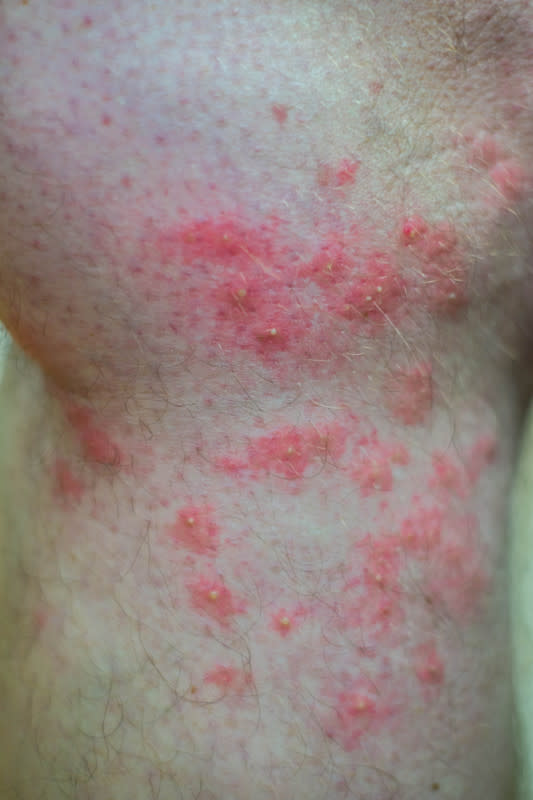
iStock
While some ants are harmless (though not fun to have in the home), Dr. Giangreco says fire ant bites are worth monitoring. People can have various reactions, with one of the most severe being allergic reactions called anaphylaxis.
"If you develop swelling of the face, hands, or feet, difficulty breathing or wheezing, abdominal pain, nausea, vomiting, diarrhea or lightheadedness, call 911 for assistance," she says. "Anaphylaxis requires epinephrine, antihistamines and other interventions. Immunotherapy is required in some cases."
Beyond that, Dr. Giangreco says fire ant bite signs include:
Redness
Burning
Hive-like reactions
Pustule with yellow fluid and burning
Swelling
Related: This Personality Change Could Actually Be a Sign of Infection, According to Doctors
8. Yellowjacket stings
While yellow jackets may have been the moniker of your high school or youth sports team, stings aren't quite the bee's knees. In fact, they vary.
"They can be a small localized reaction, a large localized reaction or anaphylaxis," Dr. Giangreco says.
Anaphylaxis warrants a 9-1-1 call. Otherwise, washing with soap and water is a best practice. A cool, damp washcloth can relieve pain. If possible, Dr. Giangreco says people can flick the stinger off the skin if it is embedded.
9. Scabies bites
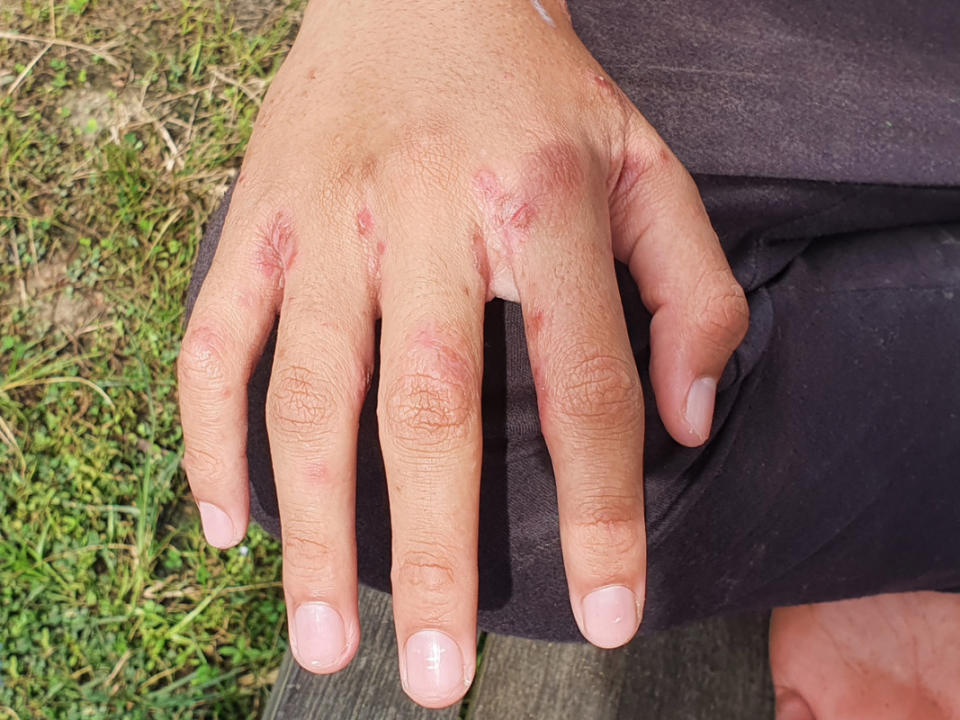
iStock
Sarcoptes scabiei, known "colloquially" (and we use that term loosely) as scabies like to burrow under the skin, per the Cleveland Clinic. Dr. Giangreco says signs of scabies bites include:
Intense itching that gets worse at night
Raised bumps which can be fluid-filled
Often found between fingers and toes
Antihistamines and anti-itch creams can soothe symptoms.
"Treat the infection with antiparasitic agents like permethrin cream or ivermectin pills," Dr. Giangreco says.
10. Wasp bites
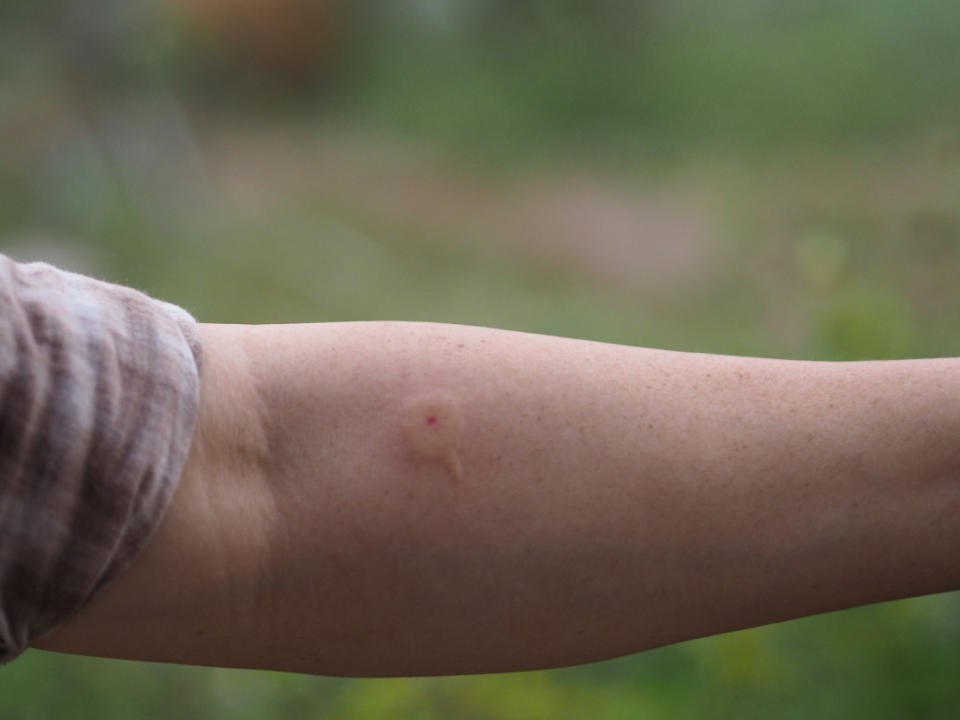
Penpak Ngamsathain/Getty Images
Just seeing a wasp nest can give you chills. Getting bitten by one? No thanks. You'll probably know if you've been bitten by one, but the immediate and long-term aftermath varies. Dr. Giangreco says the sting can cause a small or sizeable localized reaction, but anaphylaxis is also possible. Seek emergency medical care if you experience swelling in the face, hands or feet or have breathing problems, GI discomfort or dizziness following a wasp sting.
11. Flea bites
Fleas are not just a dog problem (though your pup may have made them your problem). The CDC explains that fleas feed on human or animal blood — they're tiny insects that can cause big-time irritation, though their bites are generally not life-threatening (rarely, the CDC reports that flea bites can prompt cat scratch disease, flea-borne typhus or plague).
Way more commonly? Dr. Benedict Ifedi, MD, a primary care physician with Memorial Hermann, says people can expect "small papule-like rashes that can be itchy in nature."
Dr. Ifedi says OTC itch creams, ointments and antihistamines can help you catch a break from itching. DEET-based products can help you ward off fleas in the first place.
12. Black widow bites
The Iggy Azalea song may be catchy, but black widow bites are not fun. Dr. Ifedi says they're more likely to happen when gardening, chopping wood, using outdoor furniture or cleaning the garage. Bites usually occur on limbs like legs and initially don't cause pain or symptoms. Black widow bite symptoms can begin 30 to 120 minutes after the bite and include:
Muscle pain, especially in the abdomen or back
Tremors
Weakness
Shaking
Numbness/tingling
Headache
Nausea
Vomiting
Dr. Ifedi says most people experience mild symptoms and can get by with simple wound care and oral medications like NSAIDs.
"Moderate to severe inflammation characterized by extreme muscle, chest or abdominal pain requires treatment and monitoring in the hospital where treatment includes local wound care and tetanus prophylaxis, IV medications as needed and muscle relaxers to help with muscle spasms," he says. "Antivenom may be indicated after consultation with a medical toxicologist or expert."
13. Hobo spider bites
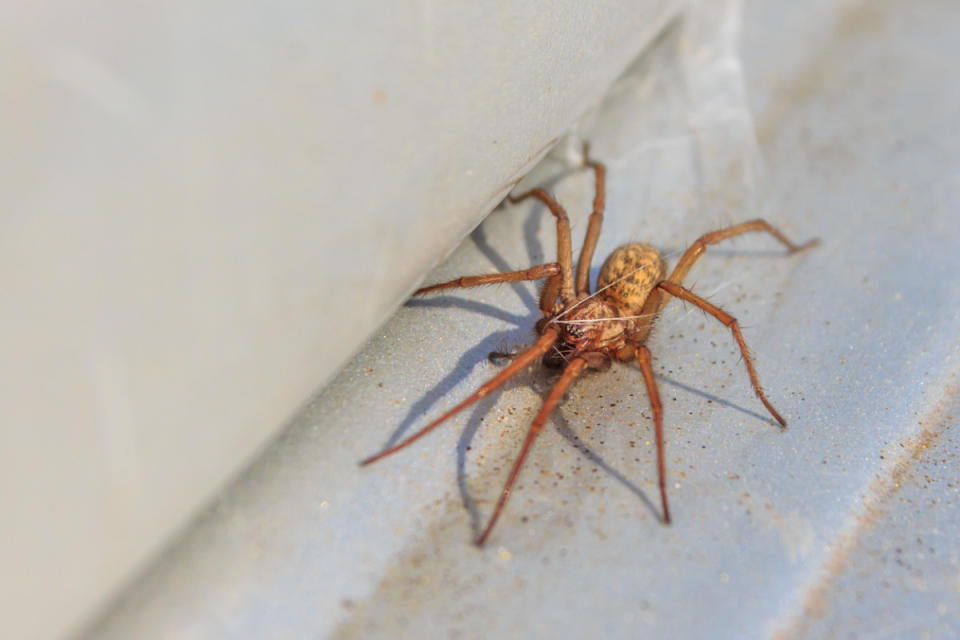
iStock
Hobo spiders are common in North America and generally not dangerous, but they bite. Dr. Ifedi says the bite is usually painless but may feel like a pinprick. Pain and redness are the most common symptoms. Time is the best healer of a hobo spider bite wound.
"Clean the area with soap and water, and use a cool compress and oral pain medication such as ibuprofen as needed," Dr. Ifedi says.
14. Deer fly bites
Deer flies are common worldwide but thrive in damp areas and sunlight. They have transparent, fan-shaped wings. Only females bite, and they do so to feast on blood.
Dr. Ifedi explains deer fly bites can trigger:
Redness and pain
Necrosis (death of the skin)
Anaphylaxis
Seek emergency care if you have breathing difficulties or other signs of anaphylaxis to get evaluated stat. Otherwise, Dr. Ifedi says cool compresses can help with symptom management, and products with DEET can aid in the best medicine (prevention).
Related: Calling All Cold Plungers! These Are the 5 Biggest Benefits of Ice Baths
15. Sandfly bites

Irena Sowinska/Getty Images
Sandfly is an umbrella term for bugs that fly, bite and suck blood in sandy areas (go figure). Getting bitten by one can be a true beach bummer. Dr. Ng says common flags of a sand fly bite red, itchy bumps that can develop into sores.
"Clean the bites, and use anti-itch creams and antihistamines for itching," Dr. Ng suggests.
Rarely can a person develop leishmaniasis, which is caused when a female from a specific sandy fly species bites. It's endemic in places like Algeria and the Eastern Mediterranean region (Iraq, Somalia, Sudan and Yemen), according to the World Health Organization.
"There are occasional reports of leishmaniasis acquired in the United States, particularly in Texas," says Dr. David Nguyen, MD, infectious disease specialist for adults and children at Rush University System for Health in Chicago.
Dr. Ng says leishmaniasis can cause:
Fever
Weight loss
Enlarged spleen
Weakness
16. Scorpion bites
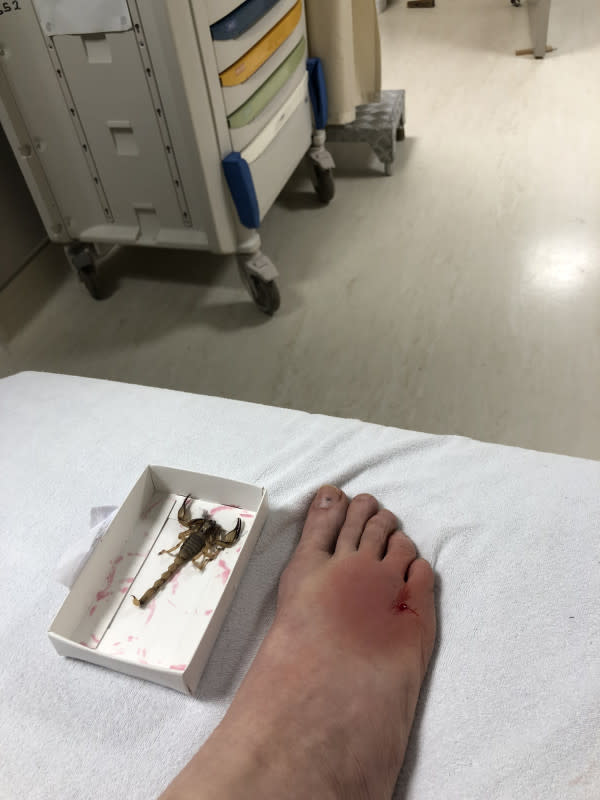
Chris Minihane/Getty Images
Even Scorpios will want to avoid scorpion bites. Dr. Ng recommends seeking medical attention for them, especially in young children or if you notice severe reactions, like muscle spasms, which could be a sign of neuromuscular issues caused by the scorpion's venom.
Other flags include:
Immediate pain
Numbness
Swelling
Dr. Ng recommends cleaning the sting site, applying a cold compress and taking pain relief medications.
17. Puss caterpillar bites
The Puss Caterpillar (Southern Flannel Moth) will fuck your world up. I grazed it twice while climbing on a float. NBD at first but an hour later I was hyperventilating on the bedroom floor. The pain was excruciating. DH took me to the ER and morphine did nothing.
by u/Totally-avg in Damnthatsinteresting
Dr. Nguyen says puss caterpillars are most common in the southern U.S.
"They are unique for having long hairs that make them appear as tufts of hair or a rabbit’s foot," Dr. Nguyen explains. "The hairs themselves hide venomous spines."
Contact with a puss caterpillar can cause:
Pain
Rash
Swelling
Nausea
Difficulty breathing
Dr. Ifedi notes they can also leave marks in the shame of a grid or tram track pattern.
Dr. Nguyen urges people to seek medical care for swelling, nausea and difficulty breathing, which are signs of more severe reactions.
18. Wolf spider bites
"Wolf spiders are common in the United States, but their venom is not poisonous to humans," Dr. Nguyen says.
However, bites aren't necessarily pleasant. Dr. Ng says you might experience:
Redness
Swelling at the bite site
Mild pain
Itching swollen area, mild pain, itching.
Dr. Ng says cleaning and cold compresses can reduce the pain. Monitor for infection.
19. Kissing bug bites
Is anyone else getting/know these gnarly bug bites? This is the first year getting them and I can’t tell what it is. I got 4 of these bites on my leg about a month ago and now on my arm. And my friend has 7 on her leg. Are they monsoon mosquitos??
by u/voodooaliens in Tucson
Kissing bug is a nickname.
"Triatomine bugs, commonly known as kissing bugs, are the major vector of American trypanosomiasis, commonly known as Chagas disease," Dr. Nguyen says. "People become infected when the skin breaks or mucosal membranes become contaminated with the bugs’ feces that carry the parasite Trypanosoma cruzii. Occasionally, people can become infected through contaminated food or drink."
Clearly, it's not nearly as romantic as the nickname implies. Also not romantic? A kissing bug bite isn't romantic. While the bite itself is painless, Dr. Ng says symptoms can develop, such as:
Swelling
Allergic reactions
Chagas disease (Fever, headache, lymphadenopathy, muscle pain, shortness of breath and swelling)
Dr. Ng advises people to seek medical attention if they believe they are having an allergic reaction or showing signs of Chagas disease.
20. Cockroach "bites"
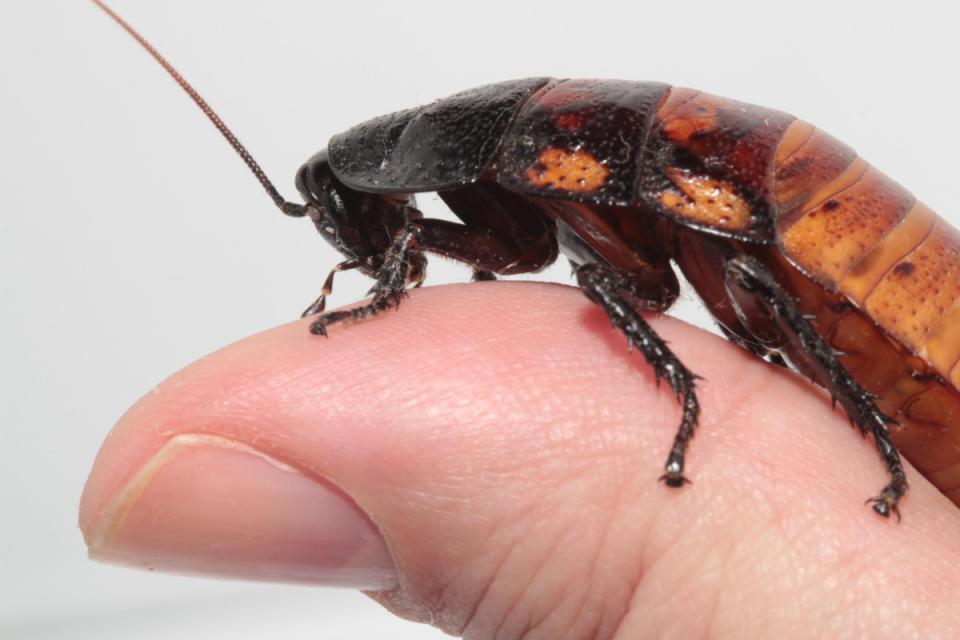
kevdog818/ Getty Images
It's rare for a cockroach to bite, and it won't puncture the skin. What's not rare? An allergic reaction to cockroaches can flare up (or present for the first time) after skin contact with one of these dreaded home invaders.
"Cockroaches themselves are not necessarily dangerous, but their presence typically indicates an area where cleanliness needs to be addressed," Dr. Nguyen says. "They can spread bacterial infections and cause allergies."
Dr. Ng says signs of this issue include:
Red bumps
Itching
Swelling
The general advice applies: "Clean the area, apply antiseptic, use anti-itch creams and monitor for infection," Dr. Ng says.
Next up: 'I'm a GI Doc—These Are the 3 Nuts I Swear By for Helping You Poop'
Sources
Dr. LouAnne Giangreco, MD, a board-certified emergency medicine physician and the chief medical officer at American Family Care
Dr. Norman Ng, DO, of the department of emergency medicine at Staten Island University Hospital
What is a horsefly bite? Cleveland Clinic.
Scabies. Cleveland Clinic.
Fleas. CDC.
Dr. Benedict Ifedi, MD, a primary care physician with Memorial Hermann
Leishmaniasis. World Health Organization.
Dr. David Nguyen, MD, infectious disease specialist for adults and children at Rush University System for Health in Chicago

 Yahoo Lifestyle
Yahoo Lifestyle 
